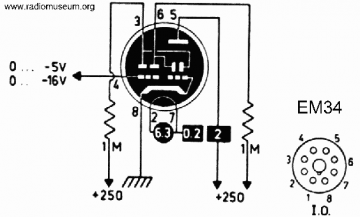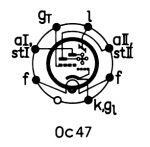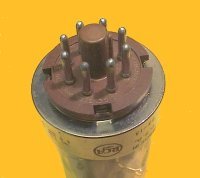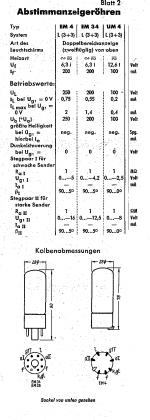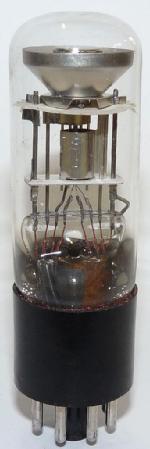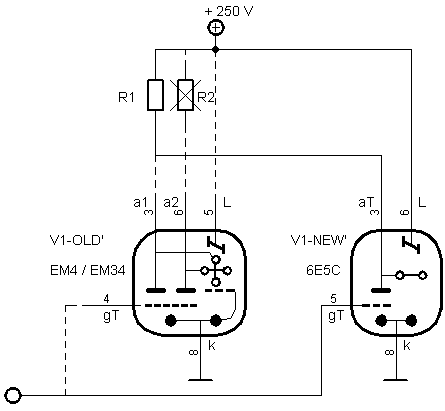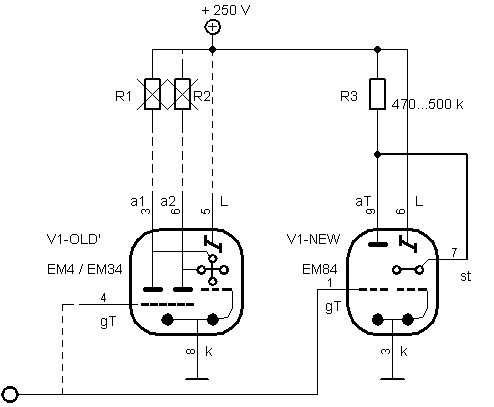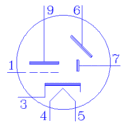
EM34
|
|
||||||||||||||||||||||||||||||||||||||||||||||||||
|
Hits: 25493 Replies: 2
Replacing the EM34 by the 6E5C
|
|
|
Jacob Roschy
03.Aug.10 |
1
In many cases it's possible to replace the rare and expensive eye tube EM34 by the Russian 6E5C (6e5s). (This 6E5C is an octal-base version of the American 6E5 (with UX6 Base)). The EM34 has two shadow angles with different sensitivity, which requires two triode units inside the bulb with different amplification as control preamps. Unlike to the EM34, the 6E5C has only one shadow angle, which then requires only a single triode. Replacing the EM34 by a 6E5C requires the urgent need of the rewiring of some socket connections, as otherwise the 6E5C will be destroyed and severe damage of the circuit may happen ! Note the base diagrams of the EM34 and the 6E5C for a proper rewiring. The 1 MegOhm resistor R1 at pin 3 (a1) will be retained, while the former resistor R2 (at a2) will be dropped.
Replacing the EM34 by the EM84 In many cases it's possible to replace the EM34 magic eye by the magic bar tuning indicator EM84, as the example by the Philips BF510A clearly proofs. On the left one can see the EM84 without input signal, which demonstrates that nothing of the indication sweep is left. The space laterally of the EM84 fluorescent bar should be covered by suitable material and colour. The EM34 has two shadow angles with different sensitivity, which requires two triode units inside the bulb with different amplification as control preamps. Unlike to the EM34, the EM84 has only one moving pattern which then requires only a single triode. Replacing the EM34 by a EM84 requires the change of the socket with adequate wiring. Note the base diagrams of the EM34 and the EM84 for a proper rewiring. Both the 1 MegOhm resistors R1 and R2 will be dropped and replaced by a new 470...500 kOhm resistor R3. Additionally a jumper between anode triode (aT) and control rod (st) is required (pin 7 to 9). Don't forget the rewiring of the heater connections.
|
|
Michael Watterson
16.Jan.12 |
2
If the 6e5s (Cyrillic 6E5C) is too sensitive (close on too weak a signal), as is likely, then put a resistor divider such as 3M3 Ohms in series with grid and 1M Ohm from grid to ground will give about 1/4 sensitivity. I just replaced an EM34 and at first the tube didn't light at all. The pins of the 1985 NOS tube had tarnished in store, a wipe with a hard "ink" eraser/rubber cured it. |
|
Don Jaksa
06.Feb.12 |
3
I used a 6E5C to replace a EM34. I was pleased with the results but the eye was too sensitive. I will use the 3M3 Ohms in series with the grid. I think I already have a 1M from grid to ground Thanks Don in Scottsdale, AZ
|
|
Hits: 18946 Replies: 0
Ersatz der EM34 durch die 6E5C (6e5s)
|
|
|
Jacob Roschy
02.Aug.10 |
1
Sofern es die Platzverhältnisse zulassen, kann als Ersatz der EM34 die russische 6E5C (6e5s) verwendet werden. Diese ist eine Octal- Version der amerikanischen 6E5 mit UX6-Sockel. Die EM34 hat zwei Leuchtwinkel unterschiedlicher Empfindlichkeit. Demzufolge ist in der Röhre eine Doppeltriode mit unterschiedlicher Verstärkung untergebracht. Im Gegensatz zur EM34 hat die 6E5C nur einen einzigen Leuchtwinkel. Eine Anzeigeänderung bewegt sich also nur in etwa ¼ des Leuchtfeldes, während der Rest nur ständig gleichmäßig vor sich hin leuchtet. Daher ist auch nur eine einfache Triode zur Vorverstärkung eingebaut. Die Octalfassung kann bei der 6E5C zwar beibehalten werden, muss aber unbedingt umverdrahtet werden, da sonst die volle Anodenspannung von 250 V über Stift 5 zum Steuergitter der 6E5C gelangt, wo sich bei der EM34 der Leuchtschirmanschluss befand ! Beachten Sie zur Umverdrahtung die Sockelschaltbilder der EM34 und der 6E5C ! Der 1 MOhm- Arbeitswiderstand R1 an Stift 3 (a1) bleibt erhalten, der bisherige Arbeitswiderstand R2 an Stift 6 (a2) entfällt.
Ersatz der EM34 durch eine EM84 In vielen Geräten lässt sich eine EM84 problemlos anstelle einer EM34 einbauen, wie hier am Beispiel eines Philips BF510A zu sehen ist. Ganz links ist die Anzeige ohne Empfangssignal, es geht also nichts vom Anzeigebereich verloren. Die EM84 sollte seitlich des Leuchtbalkens in passender Farbe zur Umgebung abgeklebt oder abgedeckt werden (was nur im Betrieb vorgenommen werden kann). Die EM34 hat zwei Leuchtwinkel unterschiedlicher Empfindlichkeit, demzufolge ist in der Röhre eine Doppeltriode mit unterschiedlicher Verstärkung untergebracht. Im Gegensatz zur EM34 hat die EM84 nur einen einzelnen Leuchtbalken, daher ist auch nur eine einfache Triode zur Vorverstärkung eingebaut. Beachten Sie zur Umverdrahtung die Sockelschaltbilder der EM34 und der EM84 ! Die beiden 1 MOhm- Arbeitswiderstände R1 und R2 entfallen, dafür erhält die EM84 einen neuen Arbeitswiderstand R3 von 470...500 kOhm. Außerdem ist an der EM84 eine Verbindung vom Steuersteg st zur Anode Triode aT vorzusehen ( Stift 7 nach 9). Vergessen Sie natürlich auch nicht die Umverdrahtung der Heizung ! |
|
Hits: 3350 Replies: 2
Lebensdauererhöhung für Magische Augen
|
|
|
Claudio Mussner
27.Nov.16 |
1
Da die Neubeschaffung von Magischen Augen immer teurer und schwieriger wird und diese zudem eine recht begrenzte Lebensdauer haben, wäre es sinnvoll, diese durch verschiedene Maßnahmen zu erhöhen. Ich denke dabei an eine Reduzierung der Anodenspannung oder den Einbau eines LDR der bei Dunkelheit die Helligkeit des Phosphor-Leuchtschirms automatisch reduziert und bei Tag wieder erhöht. Denkbar wäre auch der Einbau einer kleinen Schaltung welche den Leuchtschirm nur bei Veränderung der Gitterspannung (Sendersuche) heller werden lässt und nach einigen Sekunden wieder auf Sparflamme schaltet. Kennt jemand dazu diverse Vorschläge oder entsprechende Schaltungsanpassungen? |
|
Martin Renz
05.Jan.17 |
2
Jens Hamma, der kein Mitglied im Radiomuseum ist, hat uns freundlicherweise eine ausführliche Beschreibung für eine Dimmschaltung für magische Augen zur Verfügung gestellt. Diese ist bei einigen Röhrentypen wie der EM84 oder hier als Multiseiten-PDF herunterladbar. |
|
Joe Sousa
26.Nov.22 |
3
Der Lebensdauer von magischen Augen ist eine direkte Funktion der Elektronenzahl im Anodenstrom. Er hängt nicht auf der Spannung an der Anode ab. Mann kann dafür mit gleicher Helligkeit die Anodenspannung erhöhen, um mit anderen Mitteln der Anodenvorstrom zu erniedrigen. Dieser Artikel "Lighting up dark eyes" beschreibt eine Schaltung für die Verdopplung der Anodenspannung von ungefähr 250V bis zu 500V. Das würde auch den Anodenstrom stärk erhöhen, außer wenn man durch andere Mittel den Anodenstrom kontrolliert. Eine Lösung erfolgt durch reduzierte Heizspannung. Diese Methode braucht Experimentieren mit dem Wert des Serien- oder Shuntwiderstandes im Heizkreis. Die im oben genannten Artikel beschriebene Dimmschaltung mit gepulstem Anodenstrom ist die ideale Lösung für die notwendige Reduzierung des Anodenstroms bei erhöhter Anodenspannung. Zusätzlich zum reduzierten Anodenstrom kann eine tiefer schicht des Glühstoffs durch erhöhten Anodenspannung erreicht werden. Deshalb können blinde Augen wieder zum Glühen gebracht werden. MfG, Joe |
|
Hits: 3942 Replies: 0
EM34 Faulty and 'repaired'
|
|
|
Michael Watterson
18.Nov.11 |
1
Initially the tube was completely illuminated, though dim apart from a bright part flickering shadow open and closed about 1 or 2 degrees, but very intermittent. Mostly fully closed. The AVC/AGC and drive to grid fixed (a separate story) and the opposite shadow now fully open with no signal and closing with stronger station. But the "occasionaly flickering slightly open" shadow remained fully closed. The working shadow seems to be pin 3 (sensitive? closed g = -5V) and "broken" flickery shadow (fully closed) the pin 6 (coarse closed g = -12V?).
Repair
Background If the repair is only consideration then a 6e5s (Cyrillic 6E6C) could be fitted with wiring change or adaptor. Pure "Restoration" would see the EM34 retained. However I want to listen to this set regularly. So I may fit a 6e5s (Cyrillic 6E6C) and attach the EM34 with a note and circuit changes inside the cabinet. update: It was intermittently loading HT line, so I unplugged it and between the various electrodes apart from grid (a1, a2, T, k) in every combination connected by capacitor leakage tester with a 1uF capacitor charged on its connector (nearly 360V at very low impedance for short period). The Magic Eye is now performing perfectly though dim but just usable.
"Repaired" EM34 with weak and strong signal
|
|
Hits: 7199 Replies: 0
EM34 (EM34) Ersatz
|
|
|
Konrad Birkner † 12.08.2014
30.Nov.06 |
1
Es gibt keine Austauschtype. Da neuwertige Exemplare extrem teuer sind, und man auch zögern wird, sie durch häufigeren Betrieb zu verschleissen, bietet sich ein akzeptabler Ausweg (ausser für Puristen). Die 6E5C russischer Herkunft (hier im RMorg als 6e5s geführt, wegen der kyrillischen Buchstaben) kann die Funktion der EM34 mit folgenden Einschränkungen ersetzen: - die Beschaltung ist zu ändern Zur Beschaltung Im Gerät sollte ein Warnhinweis angebracht werden: Umgebaut auf 6E5C. Dies ist kein direkter Austauschtyp für die EM34. Bei Veräusserung eines umgebauten Gerätes gebietet es der Anstand, auf die geänderte Bestückung hinzuweisen (nicht erst nach Rückfragen)! Meine Empfehlung als Kurztext in Angeboten: Von EM34 auf 6E5C umgebaut |
|
Hits: 4153 Replies: 2
EM34 function
|
|
|
Philip Navarrete
25.Oct.06 |
1
Just what is the EM34 Eye supposed to do? My EM34 does not give the eye indication at all in FM. It's dark and blank. From what I remember the eye is supposed to open and close as stations are changed. Could I have a bad EM34? Philip Navarrete
Thread moved to tube |
|
Thomas Albrecht
26.Oct.06 |
2
Philip, The EM34 is a dual-action eye tube. It should glow brightly, with a dark wedge at both the top and bottom of the face. One of the two wedges is more sensitive than the other. For example, on a weak station, only the more sensitive wedge changes width. On a very strong station, the sensitive wedge is saturated, and the less sensitive shows some width change. If the tube doesn't glow at all, check the plate and grid voltages to make sure there isn't a problem in the surrounding circuitry. Unfortunately, it is not uncommon to find very dark or completely dark eye tubes. Most used ones have low emission. The lifetime of these tubes is only 1000 hours or so. If the radio was used frequently, the eye tube could easily have worn out in the past. Since the radio still functions fine without a working eye tube, many radio owners never bothered to replace the eye tube. Best regards, Tom |
|
Philip Navarrete
26.Oct.06 |
3
Thanks Tom I'll check the voltages. Phil |
|
Hits: 4581 Replies: 4
Looking to buy EM34
|
|
|
Philip Navarrete
25.Oct.06 |
1
Is anyone selling EM34? Philip Navarrete
Thread moved to tube |
|
Maitiu Standun
25.Oct.06 |
2 hi philip, what is em34?????? regards maitiu |
|
Arpad Roth † 27.3.17
25.Oct.06 |
3
It´s a magic eye. http://www.radiomuseum.org/tubes/tube_em34.html
|
|
Philip Navarrete
25.Oct.06 |
4
Hi Arpad, I went to that website and saw eBay Germany. I do I access that? Philip Navarrete |
|
Thomas Albrecht
26.Oct.06 |
5
Philip, An EM34 can be quite expensive. I generally see prices ranging from about US $35 to $100 on the web. Some of the least expensive offers I see advertised right now are: http://www.elexs.com/5Rcvg.htm (look under 6CD7) http://www.hamtubes.com/tubes/list2.htm I don't know whether either of these really has an EM34 in stock at these prices, but they may be worth a try. Some of the more well-known suppliers that also have EM34/6CD7 (albeit at higher price) include: http://www.radiodaze.com/tubes-03.htm http://www.vacuumtubes.com/price3.html If you shop for a tube on e-Bay, you'll need to register, and bid on the tube in an auction. Sometimes they have a "Buy it now" price where no bidding is necessary. You must be very careful on e-Bay, since you're simply buying from a private person, and there is no way to guarantee that the tube is good. You have to trust the seller's description and feedback. The reference you saw to "e-Bay Germany" on the link above (which is simply to a page here at the Radiomuseum.org site with data on the EM34 tube) is a price reported by one of the members here for a recent sale of a tube on e-Bay Germany. It doesn't mean that an EM34 is necessarily for sale right now on e-Bay Germany. Good luck! Tom |
|
Hits: 6722 Replies: 2
EM34 (EM34) Bezugsquelle
|
|
|
Werner Riethmüller
19.Dec.05 |
1
Kann mir jemand sagen wo man noch neue EM34 bekommen kann? Danke Werner Riethmüller |
|
Peter von Bechen † 15.7.19
19.Dec.05 |
2
Hallo Herr Riethmüller, neue EM34 sind nicht leicht zu bekommen. Ersatzweise macht sich die russische 6E5C ganz gut, die hat auch einen Oktal-Sockel. Allerdings muss man ein paar Drähte an der Fassung umlöten. Infos unter www.die-wuestens.de unter Röhren. |
|
Martin Steyer
19.Dec.05 |
3
Hallo Herr Riethmüller, Infos gibt es im RM, da muss man nicht außerhalb suchen: http://www.radiomuseum.org/forum/magisches_auge_6e5c_russisch_als_ersatztyp_fuer_em34_ua.html Herzlichen Gruß, Martin Steyer |
|
Hits: 5651 Replies: 3
EM34
|
|
|
Onno Massar
23.Aug.05 |
1
Hello Ernst, The indicated first production year of the EM34 in the valve should be corrected. I have 2 radio's that use the EM34 that are older: a Philips BX560A from 1947, the model was first produced in 1946. a Philips (GB) 170A/15 from 1946. Regards, Onno Massar |
|
Ernst Erb
23.Aug.05 |
2
Dear Onno Thank you very much for your comment. I have changed the date of the EM34 to 1946 - just on ground of this model of yours. One can see only very limited usage in models in 1947 and 1948 but a sharp rise in 1949. Time will show if 1946 is really correct. I have also seen sets with the EM34 for much earlyer sets (with two question marks) and corrected either the magic eye to "unknown" plus text or found the correct but later year. Only by such remarks of guests or members we can gradually find errors. Thank you. |
|
Onno Massar
23.Aug.05 |
3
Oops, the BX560A has an EM4 not an EM34. |
|
Jacob Roschy
29.Aug.05 |
4
From 1938, Philips and Mullard (owned by Philips) started to supply Great Britain with valves of the so-called "Red Series", but fitted with the American Octal base instead of the side-contact base, as usual in continental Europe. The type number was formed by adding 30 to that of the corresponding side-contact valve. The side- contact EBC3 became the Octal EBC33, the EF9 became the octal EF39,
As the Rimlock series appeared, the EM34 was allocated as tuning indicator to the Rimlock valves. So it is very likely, in continental Europe the EM34 was first found at radios fitted with Rimlock valves in the later 1940s. Best regards, Jacob Roschy |
|
Hits: 4395 Replies: 1
EM34 Leuchtstoff Alterung
|
|
|
Gottfried Silberhorn
19.Mar.05 |
1
wenn so ein magisches Auge nur noch schwach leuchtet, ist nicht die Kathode verbraucht, sondern der Leuchtstoff, das habe ich hier gelesen. 2 Fragen habe ich dazu: Altert der Leuchtstoff nur an den Stellen, wo er auch leuchtet, oder gleichmäßig überall ? Und wovon hängt die Alterung noch ab, Temperatur, oder Sonnenlicht ?? D.h. wenn ein Radio 50 Jahre in einem dunklen Keller gestanden ist, ist das magisches Auge dann noch gut ? Danke, Gottfried Silberhorn |
|
Jacob Roschy
19.Mar.05 |
2
Hallo Herr Silberhorn, bei magischen Augen verbraucht sich die Leuchtschicht nur dort, wo sie auch angesteuert wird, also leuchtet. Das kann man gut an solchen magischen Augen beobachten, die in Radios betrieben wurden, die immer nur schlechten Empfang hatten und das MA nur wenig ausgesteuert war. Steuert man dieses MA nun mit vollem Signal an, leuchtet der bisher unbenutzte Teil wie neu, auch wenn der Rest schon voll verbraucht ist. Ob Tageslicht einen Einfluss auf die Alterung hat, bezweifele ich sehr, sowas wurde noch nie berichtet. MfG JR |
|
Hits: 31413 Replies: 13
How to adapt mag.eyes like EM34 or EM85
|
|||||||||||||||||||||||||||||||||||||
|
Ernst Erb
06.Jun.04 |
1
Omer, a new member from the U.S. would like to get an answer on this topic: Even though I haven't become an official member yet, I might suggest a page or a link on your site that shows how to adapt an em34 socket to use a 6E5C tube or a link that shows how to adapt an em85 to a em80. The way vacuum tubes are available and the way audiophools are jacking up NOS tubes, I think there should be a discussion on solid state rectification as well, circuitry that wouldn't harm the vacuum tubes on start up as replacement modifications to keep old radios running. Vacuum Tube Valley in California has some recommendations. |
||||||||||||||||||||||||||||||||||||
|
Hans Kamann
19.Aug.04 |
2
The following is taken from my homepage and translated into english: Usually both screens of the EM34 are used parallel. Therefore you´ll find two resistors mounted from PIN5 (L)to PIN3 (a1, d1) and from the same PIN5 (L) to PIN6 (a2, d2). 6E5C has only one screen hence only one resistor ( 1 MegOhm) will be used:
PIN6 (L) gets the wire which was originally mounted to PIN5 (L). PIN5 (G) gets the wire which was originally mounted to PIN4 (G). The socket has to be turned by about 45 degrees since the 6E5C Screen is aligned different to the EM34 ones. We recommend keeping a sketch of the original wiring with the set.
Pinning 6E5C:
EM80 -> 6E1N It is quite easy to swap a worn out EM80 with a new 6E1N. The pinning is identical so just replace without any changes to the existing wires. Bear in mind that the dimensions of the russian type are slightly different to the EM80 but in most cases this won´t be a problem. EM85 -> 6E1N This can be a tricky one since the EM85 has, in addition to the Magic Eye, a seperate Triode System which could be used for other purposes in your radio set. So please be carefully and check schematics first ! To avoid damages to your radio set we do not propose any changes here. Below are pictures and pinnings of EM85 and EM80, taken from Franks Tube Page which is highly recommended to any radio collector http://frank.pocnet.net/sheetsE2.html. Possibly you can find a way of changing wires for your set. Above example with EM34 may help. EM85 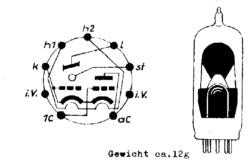 EM80 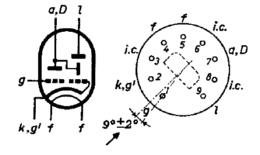
|
||||||||||||||||||||||||||||||||||||
|
Wolfgang Bauer
28.Jun.05 |
3
Ich habe dieses Mail von unserem Mitglied, Frau Marianne Gibson aus Santa Rosa, USA erhalten. A new member from USA requests tube information for EM34, other tubes, and Mystic Mystro Connection for Grundig Konzertschrank 9070 (Musical Instrument U.S.A. 9070). I am beginning to navigate the website and an looking for information on an EM34 tube. Is it suggested in this thread that the EM34 be substituted with the tubes mentioned in the above article? Some of the tubes I am searching for have an English equivalent naming, and some are not listed. Is there a possibility one of you have a name equivalent for the tubes EM34, EBC 41, EBF 89, EAA91 and EL95 ? The 9070 has a Mystic Mystro Connection that is missing on the console we are restoring. Is it a remote control of some kind? Does this thread relate to the Mystic Mystro Connection? Thank you for your assistance.
Marianne Gibson Hello Mrs. GibsonEM34 = see in the above article EBC41 = ? EBF89 = 6FD12 EAA91 = 6AL5 EL95 = ? What do you mean with "Mystic Mystro Connection" ? Do you mean the connection on the rear, it is for a cable-remote-control. Regards to you Wolfgang Bauer |
||||||||||||||||||||||||||||||||||||
|
Konrad Birkner † 12.08.2014
28.Jun.05 |
4
I am quoting the "Essential Characteristics" by General Electric: EM34 = 6CD7 EBC41 = 6CV7 EBF89 = 6DC8 EAA91 = 6AL5 EL95 = 6DL5 This is in accordance with information from the German "Franzis- Roehren-Taschen-Tabelle", 11th edition Kind regards KoBi |
||||||||||||||||||||||||||||||||||||
|
Ernst Erb
28.Jun.05 |
5
Dear Konrad Thank you for the information. I have entered those as equal types. |
||||||||||||||||||||||||||||||||||||
|
Paul Moyer
09.Nov.05 |
6 Is it possible to buy a 6E5C tube in the US? The only 6E5 tubes I have found so far do not have an 8-pin base. | ||||||||||||||||||||||||||||||||||||
|
Omer Suleimanagich
10.Nov.05 |
7
Please check out the site, http://www.thetubestore.com/ru-6e5c.html You might want to check EBay too. I hope that members of this forum again can make a collective offer to purchase vacuum tubes/valves for members, like last year! I hope this helps. Omer |
||||||||||||||||||||||||||||||||||||
|
Bob Isaac
15.Oct.10 |
8
I've found a very comprehensive page concerning 'magic eye' tube substitutions. The tube numbers listed in a 'green' color have been tested/verified, those in the color 'red' are from various published sources, but have not been tested/verified by the website author.
Using the information contained at that page, I decided to buy an inexpensive 6DG7 to replace the much more rare EM85 from a Ducretet radio I am repairing for a friend. The 6DG7 is in fact an exact electrical match to the EM85 and works flawlessly. I was able to purchase the 6DG7 for a mere $9 US from a vendor on the NET.
Thank you, Bob |
||||||||||||||||||||||||||||||||||||
|
Ernst Erb
15.Oct.10 |
9
Dear Bob really exists, as well as it is mentioned in current data books.
|
||||||||||||||||||||||||||||||||||||
|
Bob Isaac
15.Oct.10 |
10
Hello Ernst, Thank you for the information. After reading the data you provided, the one I purchased most likely IS a pentode! The brand of tube was not listed. I will let you know once it arrives. This the base diagram they listed for both the 6DG7 and the EM85 (as well as others): I had never heard of this supposed "eye tube" before reading about it at that website, but thought I would take a chance. Thanks again, Bob |
||||||||||||||||||||||||||||||||||||
|
Jan Terranea
18.Oct.10 |
11
Helo all, This magic eye thread is very interesting. The Radio Valve Data Book, (Iliffe Books LTD London 1966) mentions the EM85 made by Brimar as an obsolete type, so there may have come some successor of this tube-type. In the Muiderkring Electronic Tube Handbook 19th edition 1981, the EM85 and 6DG7 are mentioned to be the same tube with different designation. Duncan's TDSL mentions another one, the 6DH7, as identical or close to the EM85. So it is possible that there are two different tubes with the same name:6DG7 Regards, Jan Terranea.
|
||||||||||||||||||||||||||||||||||||
|
Per Abildskov
08.Jun.11 |
12
Hi Ernst, I have two brand new EM34 Magic eyes from Chelmer Valve.I was planning to use one in my beautiful Philips Royal Opera FDK543 that you kindly issued pictures of on the Radiomuseum. Unfortunately they are too wide in radius to fit the hole in the wooden cabinet. I therefore purged an 6EC5C from Germany for 25€ incl. shipping. It has a drawing with it how to modify the the connections on the socket and fits nicely. Best gards, Per. |
||||||||||||||||||||||||||||||||||||
|
Omer Suleimanagich
09.Jun.11 |
13
Be aware, the radius of the 6E5C is wider than an EM34 tube. I would suggest going in and seeing why the EM34 tube/valve is not able to fit. |
||||||||||||||||||||||||||||||||||||
|
Per Abildskov
09.Jun.11 |
14
Actually the 6EC5C is a little smaller and it fits perfectly. The problem is that the Valve has to fit inside the Philips plastic logo in the front of the radio.You are right that the original Philips EM34 is a little smaller than the 6EC5C, but by removing the filt inside the logo it worked. Regards, Per. |
||||||||||||||||||||||||||||||||||||
End of forum contributions about this tube
| Data Compliance | More Information |

